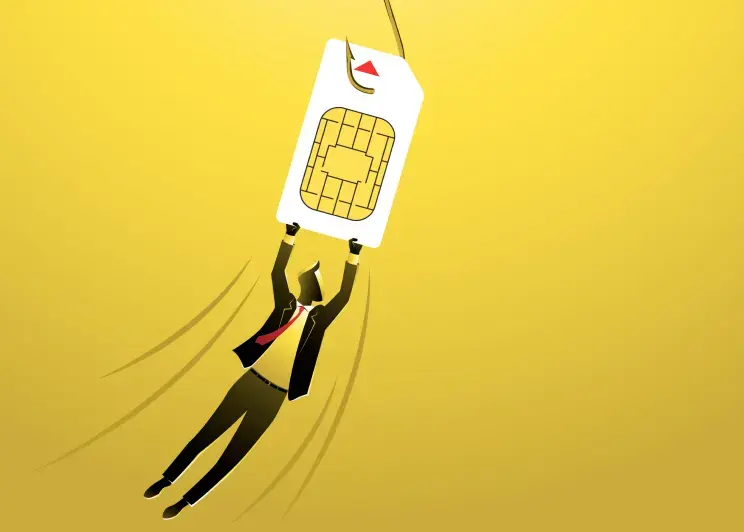Our mobile phones have become extensions of ourselves. They hold our personal information, banking details, and even our deepest secrets. They are also at risk of a sinister cyber threat called SIM Jacking. This is not just something out of a sci-fi movie; it's a real threat that has left many people, including tech-savvy professionals, completely blindsided.
After reading this, you'll understand what SIM Jacking is, learn about real-world cases, recognize the 5 signs that you might be a victim, and discover actionable tips to protect yourself. Let’s get started.
What is SIM Jacking?
SIM Jacking, also known as SIM swapping, is a type of cyber attack where criminals take control of your mobile phone number without you knowing. Watch this 40 second video to understand how it works.
Once the attackers have control of your phone number, they can reset passwords, access sensitive information, and even empty your bank accounts. Think of it as handing over the keys to your digital life to a complete stranger. And the scariest part is that it’s easy to think nothing is wrong since the phone has never left your possession.
The Market Rates for SIM Jacking
The dark web is teeming with individuals willing to pay top dollar for SIM Jacking services. In fact, some threat actors are willing to pay telecom insiders to aid in the SIM swapping process. The market rates are around $300 per successful SIM swap.
Recent SIM Jacking Cyber Attacks
The Case of Jack Dorsey
In September 2019, Twitter CEO Jack Dorsey fell victim to a SIM Jacking attack. Hackers took control of his phone number and used it to post offensive tweets on his account. If a high-profile tech mogul can be targeted, it’s a stark reminder that no one is immune to this type of attack.
The FTX Cryptocurrency Exchange Breach
In November 2022, 3 individuals were charged with stealing over $400 million in a SIM-swapping attack believed to be linked to the bankrupt cryptocurrency exchange FTX.
5 Signs You Might Have Been Hacked
1. Unexpected Loss of Service
One of the first signs of SIM Jacking is the sudden loss of service on your phone. If you find yourself unable to make calls, send texts, or use mobile data without any apparent reason, it could be a sign that your SIM card has been swapped.
2. Unfamiliar Account Activity
Keep an eye on your accounts for any unusual activity. This includes unexpected password reset notifications, login attempts from unknown devices, or unrecognized transactions. Hackers often try to gain access to financial accounts quickly once they have control of your number.
3. Inability to Access Accounts
If you suddenly find yourself locked out of your online accounts, it could be because the hackers have changed your passwords. This is often one of the first actions they take to ensure you can't regain control.
4. Strange Text Messages or Calls
Receiving strange text messages or calls can be another indicator. These could be verification codes for accounts you didn’t try to access or calls from people claiming to be your telecom provider asking for personal information.
5. Alerts from Your Mobile Carrier
Sometimes, your mobile carrier might detect suspicious activity and send you an alert. This could include notifications about a SIM card change request or warnings of unusual account activity.
5 Prevention Tips to Keep Your Phone Safe
1. Strengthen Your Account Security
Use strong, unique passwords for all your online accounts and update them regularly. Consider using a password manager to keep track of them. Additionally, enable two-factor authentication (2FA) wherever possible. Although some forms of 2FA can be compromised through SIM Jacking, app-based authenticators like Google Authenticator provide an extra layer of security.
2. Protect Your Personal Information
Be cautious about sharing personal information online and over the phone. Cybercriminals often gather data from social media profiles to impersonate you convincingly. Limit the amount of information you share publicly and review your privacy settings regularly.
3. Monitor Your Accounts Regularly
Keep a close eye on your financial and online accounts. Regularly check for any suspicious activity and report it immediately. Setting up account alerts can also help you stay informed about any changes or login attempts.
4. Contact Your Mobile Carrier
Discuss SIM Jacking with your mobile carrier and inquire about additional security measures they offer. Some carriers provide options such as setting up a PIN or password for any account changes. Make sure to enable these features to add an extra layer of protection.
5. Educate Yourself and Others
Awareness is key to prevention. Stay informed about the latest cyber threats and share this knowledge with friends, family, and colleagues. By educating others, you contribute to a safer digital community for everyone.
Wrap-up
SIM Jacking is a serious threat that can have devastating consequences. By understanding what it is, recognizing the signs, and taking proactive steps to protect yourself, you can significantly reduce the risk of falling victim to this cyber attack.
Have more cybersecurity questions? At GroupOne IT, we specialize in providing Managed IT Services that help businesses stay ahead of these challenges. Whether in a full capacity, or a co-managed relationship, we provide IT Support, Cloud Services, Cyber Security, Voice (VoIP), Consulting, Microsoft Dynamics Services and more. Simply put, we keep your systems up, your data secure and your business thriving.




